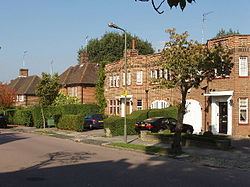OS grid reference TQ265885 Dialling code 020 | Sovereign state United Kingdom | |
 | ||
UK parliament constituencys Finchley and Golders Green, Hendon | ||
Estate agent hampstead garden suburb new homes glentree estates
Hampstead Garden Suburb is a suburb, north of Hampstead, west of Highgate and east of Golders Green. It is an example of early twentieth-century domestic architecture and town planning located in the London Borough of Barnet in northwest London. The master plan was prepared by Barry Parker and Sir Raymond Unwin. Comprising just over 5000 properties, and home to around 13,000 people, some of London's most costly properties can be found in Hampstead Garden Suburb.
Contents
- Estate agent hampstead garden suburb new homes glentree estates
- Map of Hampstead Garden Suburb London UK
- The market place falloden way hampstead garden suburb nw11
- History
- Hampstead Garden Suburb Trust
- Hampstead Garden Suburb Act 1906
- Parks and nature reserves
- Notable residents
- References
Map of Hampstead Garden Suburb, London, UK
The market place falloden way hampstead garden suburb nw11
History
Hampstead Garden Suburb was founded by Henrietta Barnett, who, with her husband Samuel, had started the Whitechapel Art Gallery and Toynbee Hall. In 1906, Barnett set up the Hampstead Garden Suburb Trust Ltd, which purchased 243 acres of land from Eton College for the scheme and appointed Raymond Unwin as its architect.
Among the scheme's aims were the following:
This required a private bill before Parliament, as it was counter to local bylaws. The provisions of the new act, Hampstead Garden Suburb Act 1906, allowed less land to be taken up by roads and more by gardens and open spaces.
The ideas for the "Garden Suburb" were clearly based on the ideas and experience of Parker and Unwin in the planning and development of Letchworth Garden City, the first development of its kind, inspired by the work of Ebenezer Howard. Other consultant architects involved with the Hampstead development include George Lister Sutcliffe and John Soutar.
However, with no industry, no public houses and few shops or services, the suburb, unlike the garden cities, made no attempt to be self-contained. In the 1930s the "Suburb" (as it is known by locals) expanded to the north of the A1. While more characterful than most other suburban housing, some of the housing to the north is considered, overall, of less architectural value.
On Central Square, laid out by Sir Edwin Lutyens, there are two large churches, St. Jude's Church and The Free Church, as well as a Quaker Meeting House. There are two mixed state primary schools in the Suburb, Garden Suburb and Brookland. There is also a state girls' grammar school, Henrietta Barnett School. The school used to house The Institute, an adult education centre, but The Institute moved first to East Finchley, then to Kingsbury and is in currently in the process of closing down altogether.
Shops and other services are provided in the shopping parade of Market Place. Shopping areas adjacent to the suburb include Temple Fortune, Golders Green and East Finchley.
Little Wood contains an open air arena, which is used for summer theatrical performances by a local amateur theatre society.
In 2015, the residents' association decided to implement a yellow and red card penalty system to discourage neighbours from using noisy lawnmowers and leafblowers.
Hampstead Garden Suburb Trust
Freehold houses, flats and commercial premises within the Suburb are subject to a scheme of management approved pursuant to the Leasehold Reform Act 1967 by an Order of the Chancery Division of the High Court, dated 17 January 1974, as amended by a further Order dated 17 February 1983.
The HGS Trust maintains the character and amenity of the Suburb and is responsible for implementing the management scheme. It has offices in Finchley Road. Freeholders are required to get the prior approval of the Trust before altering the external appearance of their properties. Consent is also required for significant changes to gardens, erection of garden sheds and felling or pruning of trees. The Trust is also the freeholder of the majority of the remaining leasehold property in the Suburb which are mostly held on very long leases.
Hampstead Garden Suburb Act 1906
Urban town planning had been restricted by the byelaws established after the 1875 Housing Act, which had de facto called for a grid iron street layout, and a minimum housing density. This had prevented Cadbury building workers houses within a city, and caused Rowntree to build his housing in rural parishes. For Unwin to design a street structure that followed the contours, and built houses in cul-de-sacs a parliamentary act was needed. The Hampstead Garden Suburb Trust sponsored a private bill.
The three relevant sections of the Act were
Section 2, defined a low building density, and wide streets with gardens or verges where trees could be planted. Section 5 distinguished between through-roads and accommodation roads, residential cul-de-sacs under 500 feet (150 m). It recognised the difference between cul-de-sac roads of limited length and other roads, and allowed the suspension of certain the operation of local planning bye-laws
Parks and nature reserves
The Suburb has large areas of open space, including Hampstead Heath Extension; Big Wood and Little Wood and the private Turner's Wood. The southern end is close to Golders Hill Park.
Notable residents
Current residents include:
